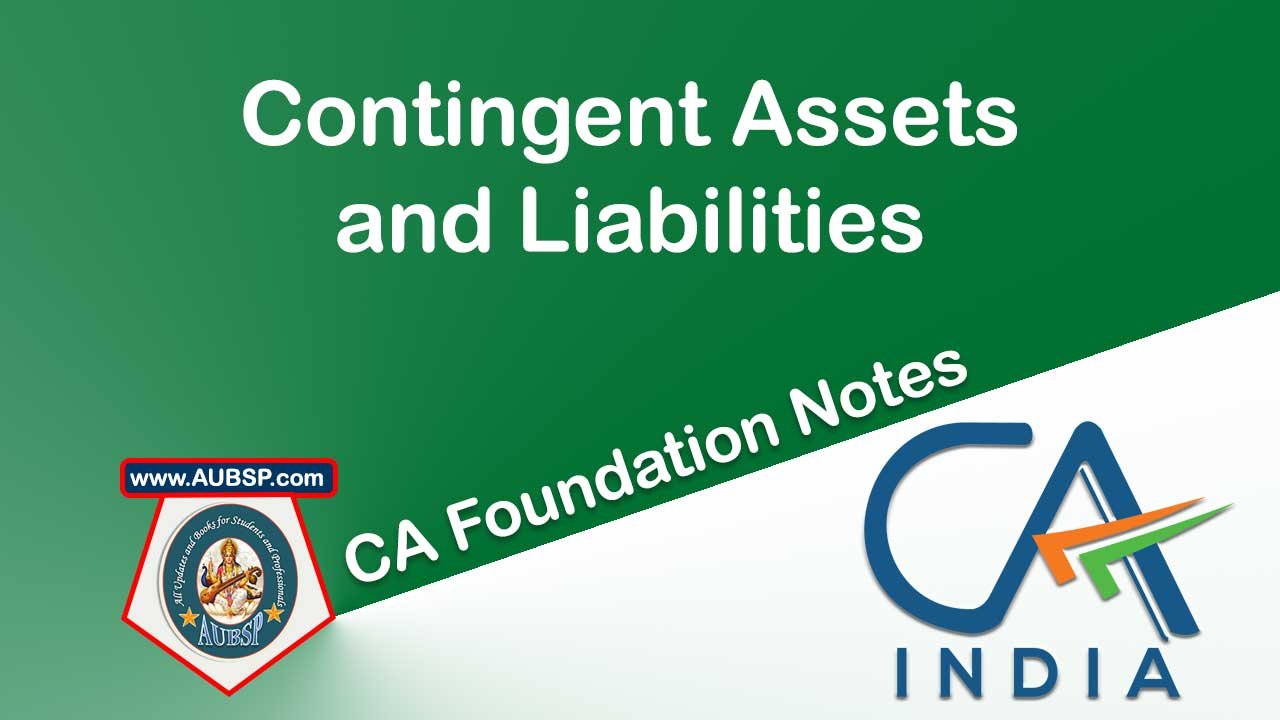Unit 4: Contingent Assets and Contingent Liabilities: Contingent assets and contingent liabilities are potential financial outcomes that depend on uncertain future events arising from past transactions. A contingent asset is a possible asset that may result in an inflow of economic benefits, but it is not recognized in the financial statements until the inflow becomes virtually certain.
In contrast, a contingent liability is a possible obligation that may result in an outflow of resources; it is disclosed in the notes to accounts unless the chance of outflow is remote. Unlike liabilities, which are present obligations recorded in the balance sheet, and provisions, which are recognized for probable obligations with uncertain amounts, contingent liabilities do not meet recognition criteria due to uncertainty in occurrence or measurability.
UNIT 4: CONTINGENT ASSETS AND CONTINGENT LIABILITIES – Exam Notes
Learning Objectives
After studying this unit, you should be able to:
- Understand the concepts of contingent assets and contingent liabilities.
- Differentiate contingent liabilities from liabilities and provisions.
1. Contingent Asset
Definition:
A contingent asset is a possible asset that arises due to past events. Its existence will be confirmed only when specific uncertain future events occur or do not occur, which are not under the complete control of the enterprise.
Key Characteristics:
- Unplanned or unexpected events give rise to it.
- Linked to possible economic gain (inflow).
- Examples include:
- Legal claims where the outcome is uncertain.
- Insurance recoveries pending confirmation.
Recognition Rules:
- Not recorded in the financial statements until realization is virtually certain.
- If inflow is probable, it is disclosed in the board of directors’ report, not in the balance sheet.
- Once realization becomes virtually certain, it is no longer contingent and is recorded as an asset.
2. Contingent Liability
Definition:
A contingent liability is:
- (a) A possible obligation from past events, to be confirmed by uncertain future events.
- OR
- (b) A present obligation, but not recognized because:
- (i) Outflow of resources is not probable, or
- (ii) Amount cannot be reliably estimated.
Real-World Examples:
- A lawsuit filed against the company.
- Claims for damages due to a product defect.
- Bank guarantees or disputes under litigation.
Treatment in Financial Statements:
- Not recorded as liability in balance sheet.
- Disclosed in notes unless the possibility of an outflow is remote.
- Continually reassessed. If outflow becomes probable and amount is measurable → it is converted into a provision.
3. Distinction Between Liability & Contingent Liability
| Liability | Contingent Liability |
|---|---|
| Present financial obligation. | Possible obligation. |
| Arises from past events. | Also arises from past events, but outcome is uncertain. |
| Outflow of economic resources is probable and measurable. | Either outflow is not probable or not reliably measurable. |
| Recognized in balance sheet. | Not recognized; only disclosed in notes. |
4. Distinction Between Provision & Contingent Liability
| Provision | Contingent Liability |
|---|---|
| Present liability of uncertain amount, reliably estimated. | Possible obligation, might not occur. |
| Meets recognition criteria. | Does not meet recognition criteria. |
| Recognized in balance sheet. | Disclosed in notes only. |
| Probability of outflow is high. | Probability of outflow is low or estimation is unreliable. |
Example:
- If a company is fined but appeals:
- If payment is likely → Provision is created.
- If unlikely → Contingent liability is disclosed.
Summary Points
- Contingent assets and liabilities stem from uncertainties.
- Contingent assets = Possible gain, disclosed only when probable.
- Contingent liabilities = Possible loss, disclosed unless remote.
- Liability = Recognized obligation.
- Provision = Recognized, though uncertain in amount.
- Contingent liability = Not recognized, only disclosed.
Test Your Knowledge – Sample MCQs & Answers
- Contingent asset usually arises from:
- ✅ (a) The possibility of an inflow of economic benefits.
- Disclosure of contingent asset when inflow is probable:
- ✅ (b) In the report of approving authority.
- Where outflow is not probable or cannot be estimated:
- ✅ (c) Contingent liabilities.
- Present liability with uncertain amount but measurable:
- ✅ (a) Provision.
- Contingent liabilities in financial statements are:
- ✅ (b) Not recognized.
True or False Practice
- Contingent liabilities need not be disclosed. → ❌ False
- A provision fails recognition criteria. → ❌ False
- Legal claim with uncertain outcome is a contingent liability. → ❌ False (it’s a contingent asset)
- Probability of payment gives rise to contingent liability. → ❌ False (this gives rise to a provision)
- Obligation from past event is called contingent liability. → ❌ False (it is a liability)
FAQs on Contingent Assets and Contingent Liabilities
1. What is a contingent asset?
A contingent asset is a possible asset that arises from past events and whose existence will be confirmed only by the occurrence or non-occurrence of future uncertain events not fully under the entity’s control.
2. Can a contingent asset be recorded in the financial statements?
No, contingent assets are not recorded in the financial statements. They are only disclosed when the inflow of economic benefits is probable and recognized only when virtually certain.
3. What is a contingent liability?
A contingent liability is a possible or present obligation that arises from past events but is not recognized in the financial statements because it is either not probable or cannot be measured reliably.
4. How is a contingent liability disclosed?
It is disclosed in the notes to accounts unless the chance of outflow of economic benefits is remote.
5. What is the difference between a liability and a contingent liability?
A liability is a present financial obligation requiring probable outflow and is recognized in the balance sheet, whereas a contingent liability is a possible or uncertain obligation that is only disclosed unless it becomes probable and measurable.
6. What is the difference between a provision and a contingent liability?
A provision is a recognized present obligation of uncertain amount but measurable with estimation, while a contingent liability is not recognized due to uncertainty in occurrence or measurement.
7. When does a contingent liability become a provision?
When it becomes probable that an outflow of economic benefits is required and the amount can be reliably estimated, it is recognized as a provision.
8. Can a contingent asset become a real asset?
Yes, if the inflow of economic benefits becomes virtually certain, it is no longer considered contingent and should be recognized as an asset.
9. Should contingent liabilities be audited?
Yes, auditors evaluate contingent liabilities to ensure proper disclosure and assess whether they require recognition based on updated information.
10. Are contingent liabilities part of the balance sheet?
No, they are not included in the balance sheet but are disclosed in the notes to accounts.
11. What are examples of contingent liabilities?
- Lawsuits pending court decisions
- Bank guarantees
- Claims under dispute
- Bills discounted
- Tax penalties under appeal
12. What are examples of contingent assets?
- Insurance claims under litigation
- Legal suits where the company expects to win compensation
- Claims for breach of contract under arbitration
13. What is the accounting treatment for a contingent asset?
It is disclosed in the Board of Directors’ report if inflow is probable and recognized only when the inflow becomes virtually certain.
14. What is prudence in relation to contingent assets?
Prudence is an accounting principle that discourages recognition of uncertain gains (i.e., contingent assets) to avoid inflating income.
15. What is meant by “virtually certain”?
It means the likelihood of the event happening is close to 100%, allowing the asset or income to be recognized in financial statements.
16. Why are contingent liabilities not recognized?
Due to uncertainty in obligation and/or the inability to estimate the financial impact reliably, they do not meet recognition criteria.
17. What happens if a contingent liability becomes probable and measurable?
It is recognized as a provision in the financial statements of that period.
18. What is the role of management in determining contingent liabilities?
Management uses judgment and available evidence to evaluate whether disclosure or recognition is appropriate based on likelihood and measurability.
19. What is a real-life example of a contingent liability?
A company facing a lawsuit that could result in damages if it loses — until the judgment is passed, it remains a contingent liability.
20. How often should contingent assets and liabilities be reassessed?
They should be reassessed at every reporting date to ensure that disclosures or recognitions reflect current circumstances.
Understanding contingent assets and liabilities is essential for accurate financial reporting and prudent decision-making. While both arise from past events, their outcomes depend on uncertain future events. Contingent assets represent potential gains and are only recognized when virtually certain, ensuring no premature income is recorded.
On the other hand, contingent liabilities represent potential obligations that are disclosed—not recognized—unless they become probable and measurable, aligning with the principle of prudence. Clear distinction from provisions and liabilities helps maintain transparency and compliance in financial statements. Mastery of these concepts is key for both academic success and professional accounting practice.



Leave a Reply
You must be logged in to post a comment.